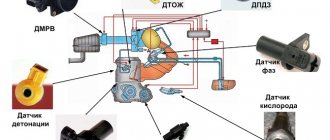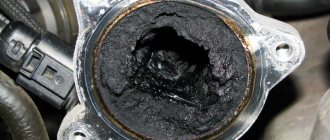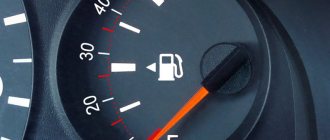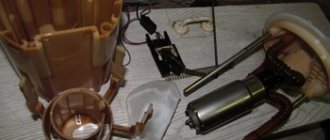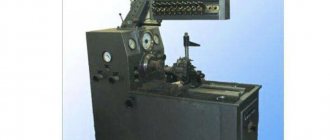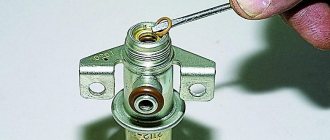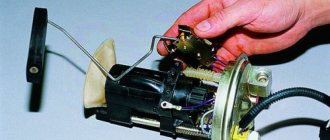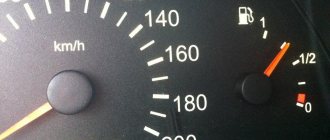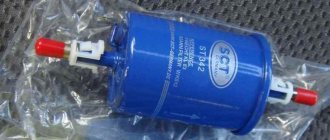The use of engines with a distributed injection system on Lada cars made it possible to stabilize the operation of the unit and reduce fuel costs in urban conditions to 10 liters per 100 km. High fuel consumption on a VAZ 2114 with an 8-valve injector indicates incorrect operation of the power system or exhaust gas emissions. The owner of the car can independently find faults and make repairs in the parking lot or in a garage.
Fuel consumption certificate
It is worth considering that there is a passport and actual fuel consumption of the VAZ Lada 2114. Quite often these two parameters do not coincide. If you believe the manufacturer, then this car with a 1.5-liter power plant in the combined cycle should consume 6.8 liters of gasoline per 100 kilometers. At the same time, consumption on the highway is 5.2 liters, in the city – 8.9 liters.
Fuel consumption per 100 km (VAZ-2114 with a 1.6-liter engine) will be 7.2/5.4/9.8 liters in mixed mode, on the highway and in the city, respectively. As you can see, the numbers are very attractive, which indicates the efficiency of the car.
However, if you believe the reviews, then on the VAZ-2114 the fuel consumption per 100 km significantly exceeds that declared by the manufacturer. With a 1.5-liter engine, the maximum gasoline consumption when driving in urban conditions is 12 liters. With a 1.6-liter engine, consumption reaches 13.5 liters per 100 kilometers. As for driving on the highway, here the parameter practically corresponds to the declared one - 5.5-6 liters per 100 kilometers. In mixed mode, the car consumes about 7.5-8 liters per hundred.
Some owners have significantly higher fuel consumption, but often there are some malfunctions with the engine or some element of the fuel system.
FACTORY SPECIFICATIONS
In any case, the fuel consumption of the VAZ 2114 per 100 km depends on the operating conditions of the vehicle. This indicator also affects the characteristics of the engine. It must be taken into account that the VAZ model was equipped with 4-cylinder engines:
- Volume 1.5 liters, 8 valves;
- Volume 1.6 liters, 8 valves;
- Volume 1.6 liters, 16 valves.
Table of gasoline consumption per 100 km. (according to data from the VAZ car manufacturer) Therefore, VAZ fuel consumption should differ slightly according to factory conditions in different modes, depending on the engine displacement and the number of valves in the cylinder head.
Simple reasons that you can eliminate yourself
Sometimes you can solve the problem of the huge fuel consumption of the VAZ-2114 yourself. First of all, you need to check the degree of contamination of the fuel filter and check it for debris. If there is debris inside it or suspicion of contamination, then it is better to replace it. This element is inexpensive, and its average price is 300 rubles. You can replace it yourself - it’s simple and does not require the intervention of a specialist.
The second filter is the air filter. Air passes through it, which is subsequently mixed with gasoline and supplied to the combustion chamber. And if it is dirty, it will not be able to pass enough air. As a result, the air-fuel mixture will not be enriched with oxygen, and a lean fuel mixture will quite logically lead to increased gasoline consumption. Car owners often manage to reduce gasoline consumption by approximately 3 liters per 100 kilometers simply by replacing the air filter. It is easy to change - it is located in a large black box under the hood.
The principle of operation of the fuel system
High fuel consumption on the VAZ 2114, then follow the instructions below. Of course, few people would want to drive such an “expensive” car and throw money away. There are not many options: go to an official service center and let them fix the shortcomings, or do it yourself, if you know a lot about it. Only in the latter case you need to be especially careful, since you can violate the warranty period, if it still exists. So, if you decide to fix everything yourself, then first you need to outline the range of sources of problems: electronic control unit (ECU), sensors, filters.
Before taking specific steps, analyze the style and manner of driving your car, brand of fuel, average speed, geographic and climatic operating conditions. It would seem like a small thing, but it can significantly increase the car’s appetite by several liters in the plus position. Drive the car into an inspection pit or overpass, let the engine cool, put on rubber gloves and begin visual diagnostics.
Pay attention to the fuel system, namely:
- Unscrew the nozzles one by one. Examine them. If you have a tester, clean it with injector fluid. Possible deposits or other foreign particles;
- Fuel pump: if there are no leaks or mechanical cracks, then the cause may be internal. You should disassemble it and clean the internal diaphragm (see the article “Signs of a fuel pump malfunction”);
- Remove and replace the gasoline filter with a new one; if there is no obvious sediment in the old one, this does not mean that it is clean. Microparticles are not visible to the human eye;
- Malfunctions in the speed sensor. At first glance, it has nothing to do with it; it may be a source of increased gasoline consumption;
- Instability in the operation of the phase sensor, which records the position of the crankshaft at certain moments of rotation;
- The oxygen sensor allows less air to pass through. The fuel system begins to starve, the mixture becomes leaner and the engine requires more ignition costs. In this case, only complete replacement, no resuscitation;
- In addition to the fuel system, we will check other components. Each part must be checked separately, so that you do not spend money on purchasing the entire set, but it turns out that the filter, for example, is to blame.
- The air filter is the second source after the fuel system. It can squeeze out a maximum of 3.0 liters/100 km. mileage
We recommend: The best ways to replace fine and coarse fuel filters on a VAZ 2109/2114/2115
Think about it, maybe it’s better to change it in time, especially since it costs a penny. And the replacement process is not complicated at all; even a schoolchild can do it without any special skills.
Spark plugs: after unscrewing them one by one, we carry out a visual inspection. An ideal candle will have a light brownish tint; all other colors are considered a malfunction. Red, black, soot, white soot are symptoms of instability in work. There are two options: either completely replacing the spark plugs or cleaning them with a household cleaner and checking the gaps between the electrode and the tip. Electrical integrity: This primarily applies to high pressure wires. Damaged ones can shoot onto the housing, thereby weakening the spark in the combustion chamber. Age and condition of the engine: perhaps the compression level is below normal or there is none at all. Check with a compression gauge and compare the data with the instructions; A simple reason is the tire pressure, which also needs to be checked with the operating instructions. As we see, there can be many reasons why the VAZ 2114 has high fuel consumption, but they can be eliminated both in a garage and in a car service center. Choose a method and go for it.
Lambda probe
One of the first and most important sensors, the operation of which can affect increased gasoline consumption, is the lambda probe. It is located on the exhaust pipe, and its main task is to assess the condition of the exhaust gases. Based on the oxygen content in the exhaust, the system regulates the volume of the working mixture. Accordingly, if the sensor malfunctions, the system will not be able to accurately regulate the working mixture that needs to be supplied to the combustion chambers. This may increase consumption.
However, if the sensor breaks down, the system warns the driver about this with a “Check” light on the dashboard. You can also see the error using the on-board computer. Often this sensor breaks down due to poor quality gasoline, oil getting into the combustion chamber, or valve clamping.
Speed sensor
Also, the cause of high fuel consumption per 100 km (VAZ-2114) may be the speed sensor. Its main task is to transmit information about the speed of the vehicle to the control unit. The latter monitors the operation of the engine by adjusting the throttle valve. The problem with this sensor will be shown by the on-board computer or error reading device. It is almost impossible to replace it yourself without specialized knowledge. Typical symptoms of speed sensor failure:
- Speedometer failure or interruptions.
- “Floating” idle speed.
- Noticeable loss of traction.
- Stopping the engine when idling.
- Increased gasoline consumption.
Increased consumption in idle mode
Typically, normal gasoline consumption when the engine is idling is 0.8-1 liter per hour. If these indicators are not exceeded, it means that everything is fine with the system. If consumption is increased, then it is worth checking the same sensors. However, special attention should be paid to the idle speed sensor, which automatically regulates idle speed. It is located on the throttle assembly and is secured with a pair of screws. The device does not have an electronic system, so its breakdown will not be displayed on the dashboard in the form of a “check”. You can judge its malfunction only by certain signs:
- Lack of high speed when starting a cold engine.
- The engine stalls when idling. This may even occur during gear changes.
- “Floating” idle speed.
How to reduce gasoline consumption on a VAZ-2114 car?
The steps are simple: you need to use high-quality gasoline, replace consumables on time (fuel and air filters, oil, oil filter), monitor the condition of the sensors, and if you suspect a malfunction, you need to contact a specialist.
Now you know what fuel consumption per 100 km the VAZ2114 has, and what elements can affect increased gasoline consumption.
High fuel consumption of the VAZ 2114 today is one of the most common problems faced by owners of domestic cars. The fuel consumption rate of the machine can be found in the technical documentation.
For the injection “fourteenth” engine, the consumption rate is within 8.5 liters per 100 km in the urban cycle and about 6.5-7 liters on the highway. But more often, VAZ 2114 owners record completely different indicators that go far beyond its limits. What is the most common problem and are there effective ways to fix it? Sometimes we are faced with the acute question of how to reduce fuel consumption on a VAZ 2114 8-valve injector?
A brief historical excursion for connoisseurs
The main differences in appearance are as follows: original headlights, additional brake light, new spoiler, etc. As for the “filling”, there have been many more changes:
- the europanel device is a front panel with two LCD displays, equipped with an overboard thermometer;
- convenient placement of emergency information in the center of the panel;
- optimal interior ventilation;
- steering column adjustment;
- heated seats;
- electric windows;
- folding rear seats.
Considering all of the above, the owners of the VAZ 2114 can only be envied. The ride quality is stable, the control unit is reliable, the steering wheel no longer blocks part of the dashboard and leaves enough space for the driver to sit comfortably. If necessary, you can easily convert your hatchback into a station wagon by simply folding the rear seats. Thus, the car becomes a utility vehicle with a large body capacity. Comfort is also an undoubted advantage due to the same heated seats and thoughtful ventilation. All this sounds great, and it would be so if not for one big drawback - the fuel consumption of the VAZ 2114. The reasons may be different, and they will be discussed further. But the fact remains: sometimes 10 or even 13 liters of gasoline are needed per 100 km, which cannot but upset car owners. Fuel consumption is actually high. Since it is necessary to protect lovers of the domestic automobile industry with all our might, we will try to understand the issue and find a way out.
What is the real gasoline consumption of VA3 2114?
Today it is a real rarity when a car fully complies with the specifications of the technical documentation. Most often, the manufacturer indicates data obtained during testing of the car under ideal conditions. The actual fuel consumption of almost all modern cars is 1-2 liters higher than the norm. You should not neglect important factors that contribute to increasing the “appetite” of the machine.
These factors are:
- Vehicle operating conditions.
- Driving manner and style.
- The presence of various types of malfunctions.
- Fuel quality.
High fuel consumption VAZ 2114 injector 8 valves, how much is this in numbers? Most owners of the 8-valve “fourteenth” note consumption in the range of 8.5 – 9 liters in the urban cycle and 7-7.5 liters per 100 km on the highway. This is an average figure that is close to the fuel consumption rate specified by the manufacturer.
conclusions
Well, in conclusion, as regrettable as it may be, the aerodynamics of the VAZ-2114 do not in any way contribute to economical movement at speeds above 110-120 km/h. Exceeding this speed and driving in this mode for a long time will also increase consumption by about 1.5-3 liters per tank of gasoline.
Don't waste your fuel and have a good trip everyone!
Enormous fuel consumption when operating a vehicle equipped with an ECM, in most cases, is attributed to electronic malfunctions. Especially if your neighbor has the same car and it uses fuel very economically. Calculating fuel in liters per 100 km is a common measure of efficiency. Just how to measure it correctly?
Fill the gasoline tank under the filler neck and roll away all the fuel. Mark for yourself the distance traveled in kilometers. Fill the tank with fuel again and find out how much fuel was consumed in liters. Please note:
* some gas stations do not top up,
* the level of fuel quality affects the distance traveled,
* note for yourself in what mode you operate the car: municipal mode, highway, warm engine.
* driving style largely determines engine efficiency.
A simple calculation: fuel tank in liters (43 l) * 100 km / distance traveled - will give you an idea of fuel consumption. If you travel more than 530 km on a tank, then this is already a good indicator, and diagnostics of the control system are unlikely to help reduce consumption. Notes:
* Driving style affects engine efficiency. Effective engine power is achieved at increased speeds of 3000 - 3500 rpm. But you need to rev the engine in the city only to later move slowly in high gear with the throttle closed.
Electronic control makes this possible. It is precisely this movement that determines the minimum fuel consumption. Greater efficiency is achieved when traveling in fifth gear at a speed of 50 km/h.
* A correctly set CO correction factor (if it is included in the system) allows you to reduce fuel consumption in municipal mode by 0.8 liters per 100 km.
* If the car is operated with a cold engine (small movements within the city) and especially in winter, there is no need to control fuel consumption. In this case, the results of measuring fuel consumption will be unpredictable.
* The technical and technical condition of the car has a huge impact on the efficiency of the engine: compression in the cylinders, valve adjustment, condition of the suspension, gearbox, etc.
* The variation in the characteristics of engines on domestic cars, other things being equal, leads to different indicators of their efficiency.
The signal from the mass flow sensor is the main one for calculating the fuel that the control system tries to supply through the injectors into the engine intake manifold. The air flow meter readings are converted according to a given line into air mass per unit of time (mass air flow).
The current engine speed received from the crankshaft position sensor allows this flow rate to be converted into cyclic air filling, i.e. find out the mass of air entering the engine cylinder during its operating cycle. Then the control system determines the composition of the mixture based on a given (calibrated at the factory) two-dimensional table in the coordinates cyclic filling / engine speed.
Through the latter, the mass of fuel for the cylinder is calculated - cyclic filling with fuel. cyclic opening, filling and fuel injector time are interconnected by a linear line of the injector. The ignition timing is selected according to the same rules as the mixture composition.
The main signs and reasons for the increase in fuel consumption of the VAZ 2114
If it’s summer and you drive on normal roads, but at the same time you notice an abnormal “appetite” of the fuel-injected 8-valve VAZ 2114, then it’s time to conduct a full diagnosis of the car’s condition. Excessive fuel consumption is easy to notice not only by the frequency of visits to gas stations. Often, owners note some oddities in the operation of the engine. Unstable operation of the “heart” of the car is accompanied by black smoke from the exhaust pipe and the presence of popping noises in the muffler or intake manifold.
Black smoke from the exhaust pipe most often occurs due to the formation of an overly rich fuel mixture. This disease occurs due to clogged injectors, faults in the ECU, and low-quality spark plugs.
Gasoline consumption can increase, both for a simple and harmless reason, and in the event of serious malfunctions in the car system. For example, a clogged fuel filter increases the fuel consumption of the “fourteenth” by as much as 2-3 liters. Low tire pressure and non-standard wheel radius also contribute. It has long been a known fact that the larger the radius of the wheel, the more effort must be made to turn it.
Spark plug
Spark plugs are the most important element in the system for supplying sparks to the cylinders. Plugs are responsible for producing a spark that ignites the fuel-air mixture in the cylinders. Their wear or non-compliance with factory requirements leads to the problem of improper detonation.
Spark plugs are a good indicator of problems with the combustion process. Black deposits on the spark plugs mean late ignition, while white deposits indicate a lean mixture. This element of the system should be changed regularly. Poor condition of high-voltage wires or a faulty ignition coil will reduce the life of the spark plugs. Their cost for model 2114 is small, so replacement should be done every 25-30 thousand kilometers.
Ways to reduce fuel consumption of a VAZ 2114 with an injector
What to do if the VAZ 2114 has high fuel consumption and the reasons are unknown? Of course, it is best to go to a service station and undergo a full computer diagnostic. The fact is that the VAZ 2114 injection system with 8 valves contains a large number of different sensors. A failure in the operation of one of them can lead to the fact that the owner of the car will rack his brains for a long time in search of faults, but will never find them without special software.
One of the most effective ways to reduce gasoline consumption by a car and its subsequent control is timely prevention of vehicle components and components and scheduled maintenance.
Not every faulty sensor affects the “appetite” of the car. The lambda probe plays the greatest role in the excessive consumption of the fuel-air mixture. This device regulates the formation of a combustible mixture based on the volume of oxygen in the exhaust. The presence of errors in the operation of the lambda probe can be determined by the on-board computer. This device most often fails due to poor fuel quality and an incorrectly set advance angle.
The car owner can independently eliminate or partially reduce the high fuel consumption of a VAZ 2114 injector with an 8-valve engine through the following measures:
- Regularly replace the air and fuel filter. In this case, preference should be given to factory elements.
- Monitor the condition of the spark plugs and replace them according to the recommendations.
- Periodically measure the tire pressure level and monitor the condition of the brake system parts.
- Refuel your car only at time-tested gas stations.
- Maintain cleanliness of components and assemblies of the engine compartment.
Oxygen controller
It has a fairly wide range of names:
The device monitors the amount of unburned oxygen in the exhaust. The signal received from the device is processed by the ECU and then a command is sent to optimize the mixture. This allows you to get rid of not only harmful emissions, but also to avoid excessive fuel consumption, but only if the sensor is working properly.
Judging by the reviews, this device rarely fails. However, it doesn't hurt to know how to check it. To do this, you will need a digital voltmeter that connects to the controller block. The reference voltage should be at a level of 0.45 V, then various situations can be simulated, for example, creating an artificial air leak if a “rich” mixture is suspected.
This method is available for self-checking. It is certainly more convenient to speed up the process and obtain complete information about which sensors affect increased fuel consumption and their parameters using a scanner.
It should be noted that it is necessary to absolutely distinguish between a malfunction of the ECU and a breakdown of any of the controllers. Timely detection of malfunctions will allow you to avoid unnecessary costs for purchasing fuel, as well as get complete satisfaction from driving. Naturally, we should not forget about other reasons for excess consumption, for example, an air conditioner will increase consumption by as much as 10%, and every extra 50 kg of cargo will add another 2%.
MAIN CIRCUMSTANCES OF INCREASING FUEL CONSUMPTION
Sponsored links. Shown only to unregistered users
While the article is under development, links to forum topics will be added later
MAIN CIRCUMSTANCES OF INCREASING FUEL CONSUMPTION
Increased fuel consumption is a headache for the modern driver, which increases along with rising fuel prices. Savings can amount to several liters per hundred, BUT organizing correct movement in the dense traffic flow of a huge city with its constant traffic jams, quite often visible traffic lights, imperfect roads and pedestrian crossings, with the windows closed and without air conditioning, is a very difficult task. for a skilled driver.
Indeed, correct driving will allow you to achieve great fuel savings. What if you don’t open the windows in the summer, don’t turn on the air conditioning, watch the tire pressure, change spark plugs and filters on time, undergo scheduled physical and technical maintenance, refuel only at proven gas stations and only with high-quality gasoline. it is possible to achieve a large reduction in fuel consumption. Every driver would like saving gas to be the task of the car, not the driver.
But, however, you need to take into account the external climatic conditions, the condition of the car, the wear and tear of its elements, assemblies and components.
So, let’s formulate the main and secondary circumstances of increased fuel consumption:
1- Driving style. Abrupt starts will not bring savings. Drive away without pressing the accelerator pedal too hard, and switch to the next gear as early as possible. If possible, try to drive in highest gear.
Proportional and prudent movement saves fuel. Calculate the road situation, avoid unnecessary movement and acceleration “at full throttle”, before the red light, take your foot off the gas pedal in advance and coast (if the road is not slippery), instead of intensively braking in front of the car standing in the first rows;
2- Driving on a cold engine (coolant temperature is lower than the calculated one). Some people advise starting the move after a couple of minutes. after the engine has started. Under load, the engine warms up much faster than at idle, but the wear of parts under such conditions will be higher.
3– A faulty radiator cap can cause either low or high coolant pressure. Due to low pressure, the coolant takes much longer to warm up, which affects fuel consumption. Excessive coolant pressure can cause it to overheat, which disrupts the processes of preparing the fuel mixture, along with this, a larger amount of fuel is wasted.
Useful video
You can learn more about the possibilities of reducing fuel consumption by watching the video below:
Maintaining the proper condition of the car in the future will save the owner from hassle and unexpected expenses. You just need to promptly replace clogged filters and damaged spark plugs, and then increased fuel consumption will bypass your car.
How to reduce fuel consumption on a VAZ 2114 is a question many car enthusiasts ask. What the gasoline consumption of a VAZ 2114 should be is usually indicated in the factory documentation. It ranges from eight to nine liters per hundred kilometers. This spread depends on the driving style and its mode (city, highway, mixed). If the indicators of your iron “favorite” fit into these frameworks, then most likely no intervention will reduce them. But if your VAZ 2114 has high fuel consumption, then this is already a reason to carry out diagnostics and most likely repair the systems of your car.
If you yourself do not have sufficient knowledge or skills, then it is better for you to contact specialized workshops where they will accurately answer the question: why the fuel consumption on the VAZ 2114 has increased.
Here we will talk about possible causes and methods for eliminating them.
Reasons for high fuel consumption on the VAZ 2114
Next, we will find out which sensors affect fuel consumption.
The lambda probe assesses the state of the exhaust (the presence of oxygen in the exhaust gases). That is, based on the volume of oxygen in the exhaust, it provides adjustment of the working mixture. It is installed in the exhaust system, it should be noted that it is the only one located on the “pipe” so you can’t go wrong. An oxygen sensor error can be seen either using the on-board computer or when undergoing diagnostics at a service station. Here are some reasons for his “death”:
- Poor quality gasoline;
- Stiff valves;
- Incorrect mixture;
- Oil scraper rings allow oil to flow into the mixture;
- The advance angle is incorrectly set.
Increased consumption in idle mode
Does the VAZ 2114 have higher fuel consumption at idle? Sensors monitor everything here too! Normal consumption, with the electrical load completely turned off, is 0.8-1 liter per hour. If this indicator is greatly exceeded on your car, then we check the sensors described below.
Idle speed sensor (ISR). Its purpose is to automatically adjust idle speed. It is located on the throttle assembly, or rather secured with a pair of screws on its cover. This sensor does not have an electronic diagnostic system and therefore its condition can only be judged by these signs:
- When starting a cold engine, high speeds are not observed;
- The engine stalls at idle;
- Idle speed “floats”;
- When you turn off the speed while driving, the gearbox stalls.
Idle speed regulator VAZ 2114
TPDZ. A device for precise dosing of the mixture or, more simply, a throttle valve location sensor. By its name you understand that its function is to “show” to the controller what position the throttle valve is currently in. It is part of the throttle assembly and is attached to its body. The malfunctions of this device are very similar to the symptoms of DXX, but it is connected to an electronic diagnostic system and if it breaks down, the “check” light will notify you about it.
In addition to all the above reasons, there are some more: insufficient compression in the engine, incorrectly set ignition timing, the gas distribution system is not adjusted, defective spark plugs, breakdown of high-voltage wires. These reasons can also negatively affect the average fuel consumption of the VAZ 2114.
If you feel the strength to eliminate them, then go ahead! If you have doubts about this, it is better to contact a specialized service center, this will help to avoid unnecessary costs.
Throttle position controller
Problems associated with this unit are expressed by the following symptoms:
- XX speed is increased;
- incorrect ignition timing;
- unstable operation of the internal combustion engine at idle;
- unbalanced composition of the air-fuel mixture;
- jerks when changing gears or difficult shifting (on cars with automatic transmission).
In addition to a violation of the XX mode, a malfunction of the Throttle Posicion Sensor (TPS) controller will not allow the car to accelerate effectively; the electronic system will incorrectly calculate the required load for the engine.
Even those who know which sensors most often affect fuel consumption are not always aware that the TPS controller on their car is involved in the operation of the automatic transmission. And from this we can conclude that an irrational choice of gear will lead to loss of power and excessive fuel consumption.
At the slightest suspicion of a TPS malfunction, you need to check two basic things:
- whether contacts XX (IDL) are opened;
- the state of the variable resistor for a break.
You can check the functionality of the sensor using a multimeter by connecting it to the IDL contacts and manually moving the throttle valve. A normally functioning TPS will immediately display a voltage of up to 12 V on the device scale.
